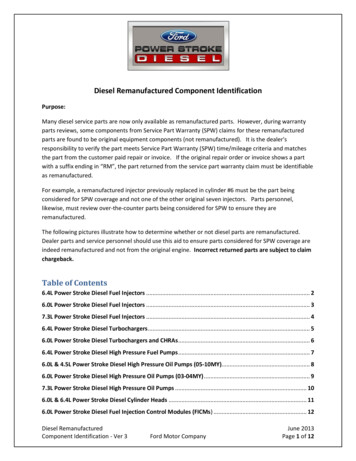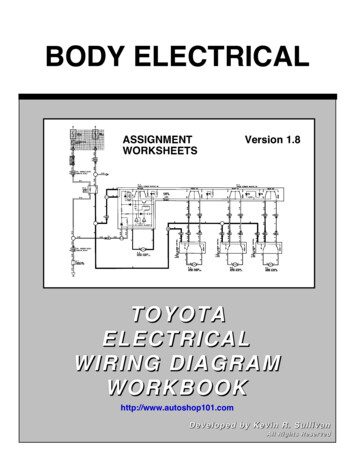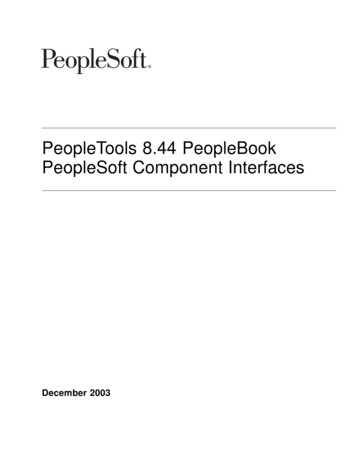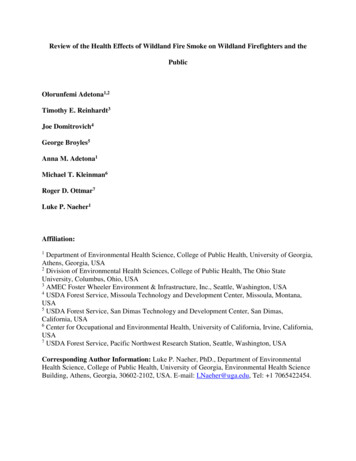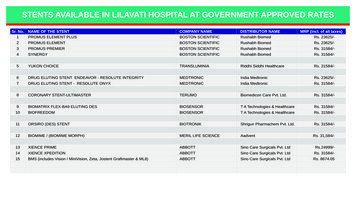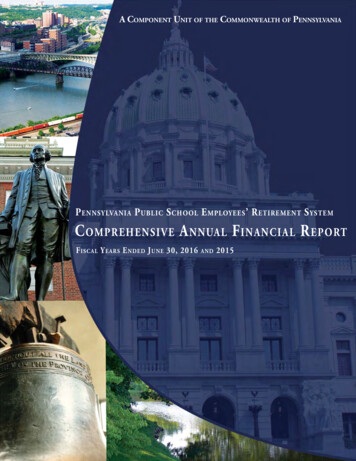
Transcription
A COMPONENT UNIT OF THE COMMONWEALTH OF PENNSYLVANIAP ENNSYLVANIA P UBLIC S CHOOL E MPLOYEES ’ R ETIREMENT S YSTEMC OMPREHENSIVE A NNUAL F INANCIAL R EPORTF I S C A L Y E A R S E N D E D J U N E 30, 2016AND2015
PennsylvaniaPublic School Employees’Retirement System(A Component Unit of the Commonwealth of Pennsylvania)5 North 5th StreetHarrisburg, Pennsylvania 17101-1905Telephone:Toll-Free 888-773-7748888-PSERS4ULocal 717-787-8540Comprehensive Annual Financial Reportfor theFiscal Years Ended June 30, 2016 and 2015Melva S. VoglerChairmanBoard of TrusteesJames M. SandoVice ChairmanBoard of TrusteesGlen R. GrellExecutive DirectorReport prepared by the Public School Employees’ Retirement SystemOffice of Financial Management Staff
Introductory SectionTable of ContentsSection One – Introductory . 5Letter of Transmittal . 6Pension Benefit Disbursement by County . 14GFOA Certificate of Achievement for Excellence in Financial Reporting. 15Public Pension Coordinating Council Public Pension Standards Award . 16Mission Statement. 17Administrative OrganizationPSERS Board of Trustees . 18Board Committees . 20Organizational Chart . 21Administrative Staff . 22PSERS Regional Offices . 23PSERS Headquarters Building . 24Section Two – Financial . 25Report of Independent Public Accountants. 27Management’s Discussion and Analysis . 29Financial StatementsStatements of Fiduciary Net Position as of June 30, 2016 and 2015 . 38Statements of Changes in Fiduciary Net Position Years ended June 30, 2016 and 2015 . 40Notes to Financial Statements . 42Required Supplementary SchedulesSchedule of Changes in the Employer Net Pension Liability . 62Schedule of Employer Net Pension Liability. 63Schedule of Employer Contributions . 63Schedule of Investment Returns . 64Schedule of Funding Progress . 64Notes to Required Supplementary Information . 65Supplementary SchedulesSchedule of Operating Expenses . 66Summary of Investment Expenses . 67Schedule of Payments to Non-Investment Consultants . 68Section Three – Investment . 69Chief Investment Officer Letter . 70Portfolio Summary Statistics Asset Allocation as of June 30, 2016 . 78Comparison of Actual Portfolio Capital Distribution to Asset Allocation Plan as of June 30, 2016. 79Graph – Comparison of Actual Portfolio Distribution to Asset Allocation Plan . 79Graph – Portfolio Capital Distribution 10 Year Trend . 8010 Largest Holdings SchedulesCommon and Preferred Stock – Non - U.S. Equity . 80Common and Preferred Stock – U.S. Equity . 81Fixed Income . 81Absolute Return . 82Postemployment Healthcare Investments . 82PAGE 2 PSERS
Introductory SectionTable of Contents (Continued)Comparison of Investment Activity Income Fiscal Years Ended June 30, 2016 and 2015 . 83Summary Schedule of Brokers’ Fees . 83Professional Consultants . 84Section Four – Actuarial . 87Actuary’s Certification Letter . 88Summary of Results of Actuarial Valuation as of June 30, 2015. 91History and Projection of Contribution Rates and Funded Ratios. 92Description of Actuarial Assumptions and Methods . 93Schedule of Active Members . 95Schedules of Retired Members and Beneficiaries . 96Solvency Tests. 97Analysis of Past Financial Experience Reconciliation of Employer Contribution Rates . 98Schedule of Funding Progress for Pensions. 99Schedule of Funding Progress – GASB Statement No. 43 Disclosure . 99Schedule of Employer Contributions for Pensions . 100Schedule of Employer Contributions – GASB Statement No. 43 Disclosure . 101Section Five – Statistical . 103Narrative. 104Schedule of Trend Data. 10510 Year Trend SchedulesTotal Changes in Fiduciary Net Position - Pension . 106Additions to Fiduciary Net Position - Pension . 107Deductions from Fiduciary Net Position - Pension . 107Total Changes in Fiduciary Net Position - Postemployment Healthcare Plans . 108Additions to Fiduciary Net Position - Postemployment Healthcare Plans . 109Deductions from Fiduciary Net Position - Postemployment Healthcare Plans . 109Summary Membership Data . 110Summary Annuity Data. 110Pension Benefit and Refund Deductions from Fiduciary Net Position. 111Average Monthly Pension Benefit Payments . 112Average Monthly Pension Benefit Payments and Average Final Average Salary . 114Average Monthly Premium Assistance Benefit Payments and Average Final Average Salary. 115Ten Largest Employers . 116Schedule of Employers . 117PSERS PAGE 3
Introductory SectionThis page intentionally left blankPAGE 4 PSERS
INTRODUCTORY SECTIONLetter of Transmittal .6Pension Benefit Disbursement by County .14GFOA Certificate of Achievement for Excellence in Financial Reporting .15Public Pension Coordinating Council Public Pension Standards Award .16Mission Statement .17Administrative OrganizationPSERS Board of Trustees .18Board Committees .20Organizational Chart .21Administrative Staff .22PSERS Regional Offices .23PSERS Headquarters Building .24
Introductory SectionLetter of TransmittalCOMMONWEALTH OF PENNSYLVANIAPUBLIC SCHOOL EMPLOYEES’ RETIREMENT SYSTEMToll-Free - 1-888-773-7748(1-888-PSERS4U)Local - 717-787-8540Web Address: www.psers.state.pa.us5 North 5th StreetHarrisburg PA 17101-1905October 27, 2016The Honorable Thomas W. Wolf, Governor of PennsylvaniaMembers of the PA General AssemblyMembers of the Retirement SystemMembers of the Boards of PSERS’ EmployersPennsylvania Public School Employees’ Retirement System Board of TrusteesDear Governor Wolf, Legislators, Members, Employer Board members, and PSERS Board of Trustees:We are pleased to present the ninety-seventh edition of the Comprehensive Annual Financial Report (CAFR) forthe Pennsylvania Public School Employees’ Retirement System (PSERS, System, or Fund) for the fiscal yearsended June 30, 2016 (FY 2016) and 2015 (FY 2015). This report is intended to provide financial, investment,actuarial, and statistical information in a single publication.The management of the System is solely responsible for the accuracy and completion of this report, pursuant tosection 24 Pa.C.S. §8502(n) of the Public School Employees’ Retirement Code (Retirement Code). The entirereport can be downloaded from PSERS’ website at www.psers.state.pa.us.The System was established on July 18, 1917 to provide retirement benefits to public school employees of theCommonwealth of Pennsylvania (PA). The members eligible to participate in the System include all full-timepublic school employees, part-time hourly public school employees who render at least 500 hours of servicein the school year, and part-time per diem public school employees who render at least 80 days of service inthe school year in any of the 781 reporting entities in Pennsylvania. As of June 30, 2016, the System had over257,000 active members with an estimated annualized active payroll of 13.0 billion.The annuitant membership at June 30, 2016 was comprised of approximately 225,000 retirees and beneficiarieswho receive over 476 million in pension and healthcare benefits each month. The average yearly benefit paid toannuitants is 25,203. The average benefit payment for each benefit type, grouped by years of credited service,is detailed in the Statistical Section of this report.In addition to retirement benefits, PSERS administers the Premium Assistance Program that provides a healthinsurance premium subsidy of up to 100 per month for those retirees who qualify. Currently, there areapproximately 90,000 retirees receiving this benefit. PSERS also manages a health insurance program, PSERSHealth Options Program, that is entirely funded through participating member premiums and provides MedicareSupplemental, Prescription Drug, and Medicare Advantage plans to over 105,000 retirees and their dependents.PSERS provides a stable source of revenue for local economies throughout Pennsylvania. In FY 2016, PSERSdistributed 5.7 billion, or over 90%, in pension benefits to retired members who reside in Pennsylvania. Thesepension disbursements are a significant economic driver that benefit the economy of the Commonwealth. Seethe Pension Benefit Disbursement by County map in the Introductory Section of this report.The System is a governmental cost-sharing, multiple-employer defined benefit pension plan, to which all membersand 781 reporting units contribute. PSERS is administered by a staff of 322. The System is headquartered inHarrisburg, Pennsylvania, and has eight field offices in strategic areas of the Commonwealth to enable directcontact with the membership and the System’s employers.PAGE 6 PSERS
Introductory SectionPSERS was established by law as an independent administrative board directed by a governing board of trustees(Board), which exercises control and management of the System, including the investment of its assets. PSERS isconsidered a component unit of the Commonwealth of Pennsylvania as defined by the Governmental AccountingStandards Board (GASB). An annual audit of the System by an independent certified public accounting firmis required by the Retirement Code. PSERS has contracted with SB & Company, LLC for this audit of itsfinancial statements and has received an unmodified opinion as evidenced in the Report of Independent PublicAccountants in the Financial Section of this CAFR. An unmodified opinion means that PSERS’ financialstatements fairly present, in all material respects, its financial condition. In addition, no significant findingswere noted during the audit and therefore, a management letter was not issued. This is the seventh consecutiveyear that a management letter was not issued by the independent public accountants and is reflective of the hardwork and dedication of PSERS’ staff to continue to improve the internal controls, operations, and efficiency ofthe System.Economic SummaryEconomically, the fiscal year was a tale of two halves. The first seven and a half months (July 1, 2015 toFebruary 11, 2016) were weak, marked by a Fed rate hike in December, expectations of multiple interest ratehikes in 2016, and risk assets falling in price. The MSCI All Country World Index, a global equity index, fellby 16.6% during this period, only to rebound 13.0% from the middle of February to June 30, 2016, for a totalreturn of negative 3.1% for the fiscal year. Commodities fell by 27.9% during the first seven and a half months,but rebounded 20.3% during the remainder of the year for a total return of negative 13.3%. U.S. long-termtreasuries were up 14.0% during the first half and continued to rise another 4.6% during the second half for atotal return of 19.3%.The U.S. economy has shown continued, albeit slow, growth this past fiscal year. Low interest rates haveprovided a low cost of borrowing so that the economy, housing, and employment conditions can continueto improve. The U.S. real Gross Domestic Product (GDP) increased an average of 1.2% per quarter duringthe past fiscal year with a range of 0.8% to 2.0%. Housing during the past fiscal year has shown continuedimprovement, up around 4.6% as measured by the S&P Case-Shiller 20-City Home Price Index.Economic conditions continue to be very weak in Europe as aggressive European Central Bank policies havebeen unable to generate any significant improvements in economic growth, employment, and inflation. TheUnited Kingdom (U.K.) held a non-binding referendum to determine if the U.K. would remain in or leavethe European Union (EU), where the U.K. had been a member since being admitted in 1973. The polls allsuggested prior to the vote that the U.K. would remain; however, its citizens voted to leave. Global risk markets(equities, commodities, credit) heavily sold off for a couple days immediately following the vote; however, theyrebounded quickly. The long-term impacts have yet to be determined. While the Euro Area economy is weak,Japan’s economy may be even weaker. As of the first quarter 2016 (the latest data available), Japan’s real GDPincreased by 0.1% over the past year. China had robust growth compared to the other developed regions of theworld. China’s real GDP increased by 6.7% over the past year, slightly slower than the 7.0% pace as of June2015. Inflation in China has remained relatively stable over the past year at 1.8% compared to 1.4% last year.The Board has continued to fulfill its mission to maintain stability and the long-term optimum value of the Fund.This is evidenced in the long-term growth of the System’s assets and the actuarial soundness of the Fund. Theannualized time-weighted rate of return for the twenty-five year period ended June 30, 2016 was 8.18% andexceeded the Fund’s long-term investment rate of return assumption. Of utmost importance to the Board is theassurance that the required reserves are available for payment of retirement benefits.Status of Pension Funding InitiativesAs the annual savings from the reduced Act 120 benefit structure increase and higher employer contributionsare paid by school employers and the Commonwealth, PSERS is approaching a turning point.As noted in the FY 2015 CAFR, for many years the Commonwealth and school employers paid below theannual required contribution (ARC) that was necessary to pay down the unfunded liability of the System. TheARC percentage received fell to a low of 27% before significant pension reform was enacted in 2010.PSERS PAGE 7
Introductory SectionAct 120 of 2010 made dramatic progress toward addressing the funding issue at PSERS. Since 2010, Act 120increased employer contributions to the System and for the first time in 15 years, the employer contribution ratefor the fiscal year ending June 30, 2017 (FY2017) provides 100% of the actuarially required rate based on soundactuarial practices and principles.As a result of the increased funding, in approximately two years, PSERS’ funded ratio is projected to slowlyimprove after declining for many years and has put PSERS on a path to eventual full funding.As of June 30, 2016, approximately 58,000 of PSERS’ active membership is under the reduced benefit structureof Act 120. The annual savings from the reduced benefit structure continue to grow and exceeded 90 millionin FY 2016.Act 120 also provided for an innovative shifting of investment risk to members through a “shared risk” concept.New members hired after July 1, 2011 now share a portion of the investment risk of the Fund, giving PSERSa defined contribution element. Under the “shared risk” concept, members share some of the risk wheninvestments underperform. The member contribution rate will stay within the specified range allotted; but couldincrease or decrease by 0.5% every three years, dependent on investment performance of PSERS.The first risk share measurement occurred in 2014. As a result of the Fund’s 8.66% three year return throughJune 30, 2014 exceeding the investment performance hurdle mandated by Act 120, the member rate did notchange. The next measurement to determine risk share will occur in FY 2017.Pension Legislation UpdateThroughout FY2016, PSERS staff was actively engaged in providing actuarial data, legislative analyses, andrelated technical information to members of the General Assembly and Executive Branch Officials on a rangeof pension policy proposals while remaining policy neutral on plan design elements of legislative proposals.Significant discussion on additional pension reform continues to take place. As of the date of this letter, therehas been no consensus on pension reform and no pension legislation beyond Act 120 of 2010 has been enacted.The current Legislative Session ends Sine Die (without a day remaining) at midnight, November 30, 2016. Anypension bills that have been introduced but not enacted will be disposed of at the end of the Legislative Session.Major InitiativesPension Administration System UpgradeThe multi-year effort to upgrade the System’s entire core client-server based pension administration systemcontinues. This mission critical system is used by PSERS’ staff members and employers to execute PSERS’primary pension administration functions for its members. These functions include, but are not limited to:enrolling new members; processing membership class elections; reporting and processing employee andemployer contribution data; processing member demographic, salary, and service data; processing purchase ofservice, multiple service, disability, retirement, and refund applications; processing death benefits; supportingthe Health Options Program; processing premium assistance applications and payments; issuing benefitpayments related to the above activities; calculating and posting interest and delinquencies, and payments andreceipts related to the above activities; providing self-service functionality to PSERS’ members via the internet;calculating, submitting, and reporting tax information and dollars to the Internal Revenue Service (IRS); andreporting information to PSERS’ actuary.This upgrade from the existing “classic” version to a new “browser-based” version not only helps ensure theviability of PSERS’ core pension administration system into the future, but also provides an enhanced “baseline”platform with built-in features that will make future enhancements much easier to implement. Enhancementsincluded with the initial introduction of this upgraded pension administration will provide opportunities formembers and employers to conduct transactions for themselves that would have previously required staffintervention. Some of these initial self-service features include: updating home mailing address, phone numberand email information; setting preferences for receiving paper or electronic documents; electing Class T-E orT-F at qualification; electing multiple service membership; designating and updating beneficiaries; creatingpersonalized retirement estimates by using an online calculator; viewing disbursements; calculating federalPAGE 8 PSERS
Introductory Sectiontax withholding using an online calculator; viewing and updating pension payment tax withholding; viewingcorrespondence from PSERS such as letters, newsletters, Statement of Accounts, and 1099Rs; and receivingPSERS-related news and alerts. These changes will not only directly increase customer service opportunities,but will also generate financial savings while possibly enabling PSERS to redeploy staff to other critical needsas workloads shift.Budgetary and Financial GovernancePSERS submits its administrative budget request to the Governor’s Office of the Budget each October to bereviewed and evaluated. Any changes proposed by the Governor’s Budget Office are made and a final amountis provided to the Legislature for their consideration. The Legislature passes the final budget and submits itto the Governor for his signature, after which it becomes law. The administrative budget is not funded fromthe Commonwealth’s General Fund, but rather from the earnings of the Fund itself. Historically, PSERS hasunderspent its approved budget, keeping more funds available to invest for PSERS’ members.PSERS continues to be prudent in its use of funds and managing its annual budget. In FY 2016, PSERS enteredinto a new agreement for its hardware and server maintenance resulting in significant savings. PSERS reducedmailings to members, producing savings in both printing and postage costs. Working with its actuary, PSERScontinues to save actuarial fees by completing various analyses in-house. Other reductions were made to wages,overtime, travel, and training, all part of PSERS’ ongoing efforts to control costs and improve operationalefficiency.PSERS participates in an independent, international benchmarking survey evaluating its costs and serviceperformance in comparison to other similar public pension funds. Based on the most recent survey, PSERS hada 16% lower pension administration cost per member than the average cost for its peer group. By running a leanand efficient operation, PSERS saves the
Health Options Program, that is entirely funded through participating member premiums and provides Medicare Supplemental, Prescription Drug, and Medicare Advantage plans to over 105,000 retirees and their dependents. PSERS provides a stable source of revenue for local economies throughout Pennsylvania. In FY 2016, PSERS




